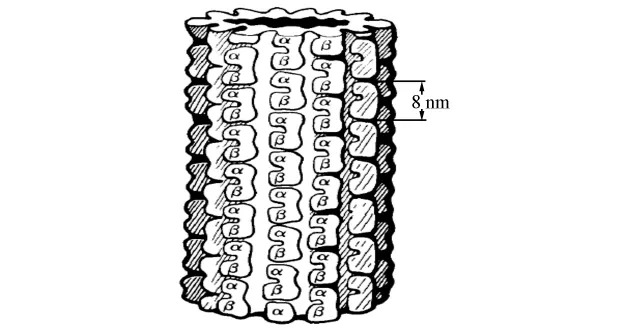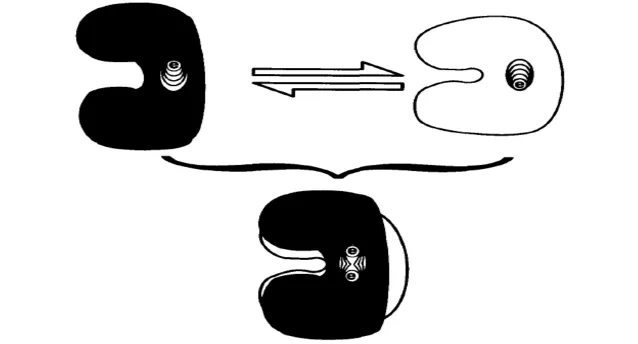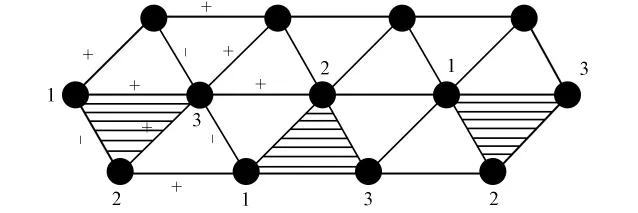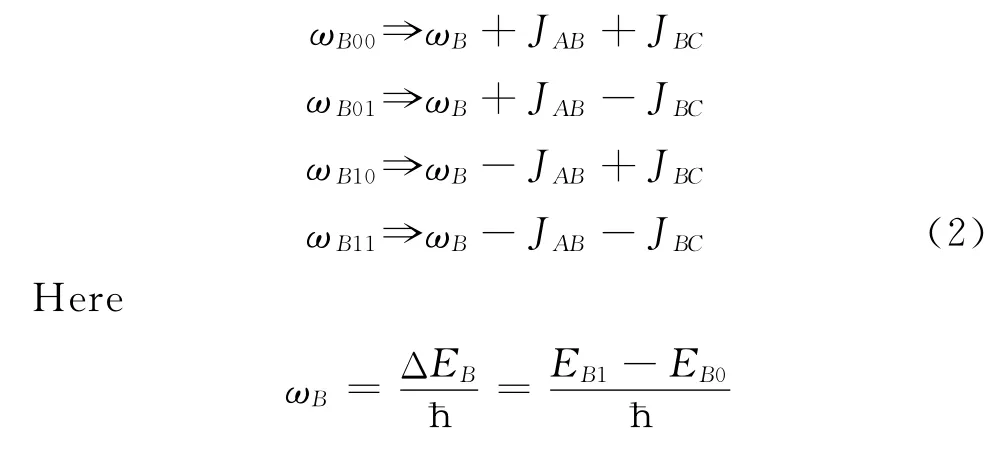Quantum Information Process in the Brain
GAO Feng,ZHANG Deng-Yu,TANG Shi-Qing
(Department of Physics and Electronic Information Science,Hengyang Normal University,Hengyang Hunan 421008,China)
Quantum Information Process in the Brain
GAO Feng,ZHANG Deng-Yu,TANG Shi-Qing
(Department of Physics and Electronic Information Science,Hengyang Normal University,Hengyang Hunan 421008,China)
In this paper,according to theα-monomer andβ-monomer in the cytoskeletal microtubules and Lloyd's schemes for loading and processing of information in the wall of microtubules,quantum information process in the cerebral nervous system is discussed.We conclude that there is a quantum information process in the tubulin.Further,the quantum information process in cytoskeletal microtubules is described based on the pseudo-spin atoms model,and system's Hamiltonian is discussed.
quantum information;brain;microtubule;Hamiltonian
0 Introduction
The prospect of quantum computing(QC)has caused great excitement in physics and computing,recently.If a set of qubits can be maintained in a coherent,controllable many-body state,certain very difficult computational problems become tractable.In particular,successful QC would mean a revolution in the areas of cryptography and database searching.In addition,it would mean a great advance in general quantum systems and their interactions would represent a new era in nanotechnology[1-4].But large quantum systems are notoriously difficult to analyse rigorously,except in highly idealized models or limits.Estimates based on the same unrealistic one-particle model,applied to trillions of interacting particles,show discrepancies of ten orders of magnitude in the work of different authors.It is therefore better to turn to hard experimental realities and abstract computational theory to find the neural correlates of quantum processes in the brain[5].Usually,we assume that minimal system for carrying a bit of information is an atom with two states,which can be populated either in the ground state|0>,or in the excited state|1>.Accordingly,information can then be represented by a set of atoms,some of which are in the groundstate|0>and others in the excited state|1>.
Brain is the most sophisticated and complex organ.All the mental activity and cognitive function,such as feelings,sports,skills,languages,thinking,emotion,personality,and so on,are controlled by brain.Thus,uncovering the operational principle of the brain is a very important task for human society.Untill now,people have very little knowledges for brain and can not give a satisfactory answer topsychological and cognitive function,although long efforts have been made by inverstigating in several levels,such as cell,molecue,and nucleus.
In this paper,our aim is to discuss the quantum information processing in the brain,including the relation between quantum information and higher brain functions.
1 Microtubuleinthenervouscell
Interiors of living eukaryotic cells(including the brain's neurons and glia)are organized by integrated networks of protein polymers called the cytoskeleton.In addition to“bone-like”support,these dynamic self-organizing networks appear also to play roles as each cell's circulatory and nervous systems.
According to the X-ray crystal diffraction experiment,Amos pointed out that nerve cells contain affluent microtubules(MTs)in 1974(Fig.1)[6].The cytoskeleton consists of MTs,actin filaments,intermediate filaments and microtubule-associated proteins(MAPs)which,among other duties,link these parallel structures into networks.For a biological system,MTs are important for components and function units in cytoskeletons,so the problem of information processing of MTs has at tracted additional attention.
The most prominent cytoskeletal component,MTs are hollow cylindrical polymers of the protein tubulin and are 25nm in outer diameter and 14nm in inner diameter.MT cylinder walls of microtubules are comprised of 13longitudinal protofilaments in which each is a series of tubulin subunit proteins.Each tubulin subunit is a polar,8nm dimer which consists of two slightly classes of 4nm,55 000dalton monomers known as alpha and beta tubulin (α-andβ-tubulin).The tubulin dimer subunits within MTs are arranged in hexagonal latticee which is slightly twisted,resulting in differing neighbor relationships among each subunit and its six nearest neighbors,and helical pathways which repeat every 3,5and 8rows.
MTs,as well as their individualtubulins,have dipoles with negative charges localized towardαmonomers.Thus are“electrets”:oriented assemblies of dipoles which are predicted to have piezoelectric and ferroelectric properties.Biochemical energy is provided to the cytoskeleton in at least two ways:tubulinbound GTP is hydrolyzed to GDP in MTs,and MAPs are phosphorylated.Each tubulin has a large hydrophobic region,a non-polar pocket of amino acid side groups which interact by van der Waals forces and can support quantum level electron delocalizability.

Fig.1.Microtubules structure from x-ray crystallography
MTs self-assemble and disassemble.The different configurations they assume by their assembly and MAP attachments determine cell form and function including synaptic connections in neurons.Cell architecture (and synaptic connections)can quickly adapt MT disassembly,and subsequent reassembly and MAP network formation in another shape or direction.Many organized cytoskeletal functions are carried out by MAPs.Some MAPs(dynein,kinein)act as motors and carry material along microtubules(axoplasmic transport)[7].
2 Informationprocessinginthebrain
The physical systems with two states can act as a bit in quantum information,which can be populated either in the ground state|0>,or in the excited state|1>.Frohlich proposed that the various factors determining protein conformation were integrated through a quantum level dipole oscillation within each protein's hydrophobic region(Fig.2)[7-8].

Fig.2.Schematic model of tubulin states.Top:Two states of microtubule subunit protein“tubulin”in which quantum event(electron localization)within a hydrophobic pocket is coupled to protein conformation.Bottom:Tubulin in quantum coherent superposition of both states
How might the cytoskeleton signal and process information?Tubulin can undergo several types of conformational changes.Roth and Pihlaja suggested that patters of tubulin conformation within MTs represented information[9].In one example of tubulin conformational change observed in single protofilament chains,one monomer can shift 27degrees from the dimer's vertical axis.Whether such mechanical deformation occurs in tubulin within intact MTs is unknown;neighbor tubulins in the MT lattice might be expected to constrain movement.However,cooperayivity among tubulins bound loosely in the MT lattice by hydrophobic forces could coordinate conformational changes,and support propagation of wave-like signals in MTs.Vassilev demonstrated signal transmission along tubulin chains formed between excitable membranes[10].A number of models of signaling and information processing within MTs and other cytoskeletal components have been suggested.These include propagating tubulin conformational changes,ion transfer,sequential phosphorylation or dephosphorylation along MT tubulins,tensegrity,non-linear solition waves along MTs and“cellular automaton”behavior due to electrostatic dipole coupling among tubulin lattice neighbors[11].
The tubulin dimer subunits within the wall of the MT are arranged in a hexagonal lattice which is slightly twisted.Hence,the entire MT wall can be mapped the chain of atoms shown in Fig.3[12].

Fig.3 The chain of atoms in the cerebral nervous cells
We can apply Lloyd's schemes for loading and processing of information in the wall of MTs.Then,we can describe the repeated cell as three types of two-p seudo-spin atoms.Its Hamiltonian takes a simple form as

where^σiis the Pauli operator,J is the effective constant of interaction which can be positive or negative,andωis the resonant frequency for the effective spin when the interaction is absent.Take B atoms as example,if some state of B atoms in the system is in the ground state or the spin of the down,we find the following four eigen frequencies of the Hamiltonian which correspond to four energy levels speit by energy level of Batoms

Similarly,the four frequencies of A atoms and C atoms can be given.
Rasmussen's MT automata patterns can thus represent and process information through each cell;gliders may convey signals which regulate synaptic strengths,represent binding sites for MAPs(and thus neuronal and synaptic connectionist architecture)or material to be transported.Information could become“hardened”in MTs by tubulin modifications or stored in neurofilaments via MAPs.MT conformational automata patterns provide a further level of computational complexity within each of the brain's neurons.However,by considering only classical computing and local neighbor interactions,microtubule automata fail to address the problematic features of consciousness for which quantum theory holds promise.
3 Discussion
Research of quantum computation and information has become a hotspot in the physics and computational sciences,and propels the progress of many research areas since the 1980s.Quantum computation and information are an active area of mordern physics,people are trying to find physical systems to realize them.Recently,quantum computation and information are applied widely to life science enviroment[5,7-8][11-13].In this paper,we discussed quantum information processing in the cerebral nervous system.
We assumed that minimal system for carrying a bit of information is an atom with two states based on theα-monomer andβ-monomer in the cytoskeletal microtubules.We further conclude that system's Hamiltonian according to Lloyd's schemes for loading and processing of information in the wall of MTs.However,brain is the most sophisticated and complex organ,which is more advanced out there than people assumed quantum computer.The process of storing,processing and transmitting information in the cerebral nervous system is still unclear,it is very necessary for us to further make an inquiry.
[1]Divincenzo D P.Quantum computation[J].Science,1995,270(10):255-261.
[2]Benett C H.Quantum information and computation[J].Physics Today,1995,48(10):24-30.
[3]Nielsen M A,Chuang I L.Quantum computation and quantum information[M].London:Cambridge University Press,2000.
[4]GAO Feng,ZHANG Denyu,CHEN Qiucheng,et al.The quantum dots in quantum computation[J].Journal of Hengyang Normal University,2005,26(6):24-27(in chinese).
[5]Koch C,Hepp K.Quantum mechanics in the brain[J].Natrue,2006,440(30):611-612.
[6]Amos L A,Klug A.Arrangement of subunits in flagellar mircrotubules[J].J Cell Sci.,1974,14:523-549.
[7]Hameroff S,penrose R.Orchestrated reduction of quantum coherence in brain microtubules:Amodel for consciousness[J].Mathematics and Computers in Simulation,1996,40:453-480.
[8]Frohlich H.Long range coherence and the actions of enzymes[J].Nature,1970,228:1093.
[9]Roth L E,Pihlaja D J.Gradionation:Hypothesis for positioning and patterning[J].J.Protozoology,1977,24(1):2-9.
[10]Vassilev P,Kanazirska M,Tien H T.Intermembrane linkage mediated by tubulin[J].Biochem.Biophys.Res.Comm,1985,126:559-565.
[11]Rasmussen S,Karampurwala H,Vaidyanath R,et al.Computational connectionism within neurons:A model of cytoskeletal automata subserving neural networks[J].Phys.D,1990,42:428-449.
[12]Shi Chunhua,Qiu Xijun.Quantum Information Processing in the Wall of Microtubule[J].Nuclear Physics Review,2005,22(4):407-410.
[13]Gao Feng,Xiao Detao,Zhang Denyu.Low-frequency electromagnetic radiation field interaction with cerebral nervous MT[J].Nuclear Physics Review,2009,26(4):343-347(in chinese).
大脑中的量子信息过程
高 峰,张登玉,唐世清
(衡阳师范学院 物理与电子信息科学系,湖南 衡阳 421008)
根据细胞微管骨架的α-构型和β-构型,并利用Lloyd关于微管壁上量子信息过程的构想,讨论了大脑神经系统中的量子信息过程。研究表明,在微管蛋白中肯定存在量子信息过程,我们利用赝自旋原子模型讨论了系统的哈密顿量。
量子信息;大脑;微管;哈密顿量
CLC nunber:Q684
AArtical ID:1673-0313(2012)03-0036-04
date:2011-12-30
Biography:Gao Feng(1960-),male,native of Hengyang,Professor,Department of Physics and Electronic Information Science,Hengyang Normal University,Hunan.
——水芹主要害虫识别与为害症状
——庆祝湖南农业大学草业科学系建系20 周年
